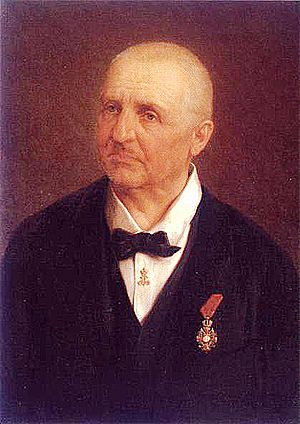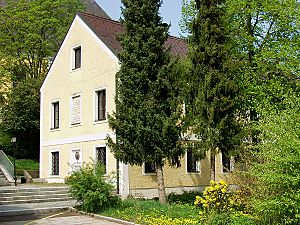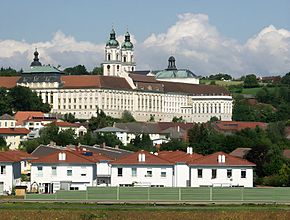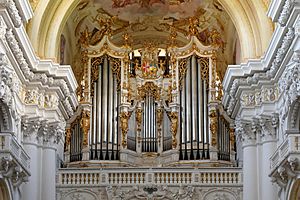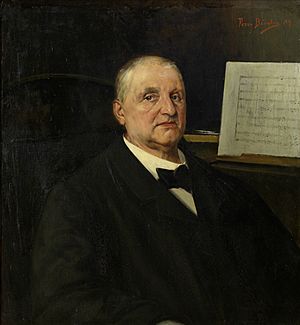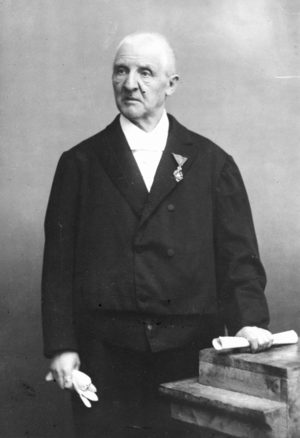Anton Bruckner facts for kids
Josef Anton Bruckner ( 4 September 1824 – 11 October 1896) was an Austrian composer and organist best known for his symphonies and sacred music, which includes Masses, Te Deum and motets. The symphonies are considered emblematic of the final stage of Austro-German Romanticism because of their rich harmonic language, strongly polyphonic character, and considerable length. Bruckner's compositions helped to define contemporary musical radicalism, owing to their dissonances, unprepared modulations, and roving harmonies.
Unlike other musical radicals such as Richard Wagner and Hugo Wolf, Bruckner showed extreme humility before other musicians, Wagner in particular. This apparent dichotomy between Bruckner the man and Bruckner the composer hampers efforts to describe his life in a way that gives a straightforward context for his music. Hans von Bülow described him as "half genius, half simpleton". Bruckner was critical of his own work and often reworked his compositions. There are several versions of many of his works.
His works, the symphonies in particular, had detractors, most notably the influential Austrian critic Eduard Hanslick and other supporters of Johannes Brahms, who pointed to their large size and use of repetition, as well as to Bruckner's propensity for revising many of his works, often with the assistance of colleagues, and his apparent indecision about which versions he preferred. On the other hand, Bruckner was greatly admired by subsequent composers, including his friend Gustav Mahler.
Contents
Life and career
Early life
Anton Bruckner was born in Ansfelden (then a village, now a suburb of Linz) on 4 September 1824. The ancestors of Bruckner's family were farmers and craftsmen; their history can be traced as far back as the 16th century. They lived near a bridge south of Sindelburg, which led to their being called "Bruckhner an der Bruckhen" (bridgers on the bridge). Bruckner's grandfather was appointed schoolmaster in Ansfelden in 1776; this position was inherited by Bruckner's father, Anton Bruckner Sr., in 1823. It was a poorly paid but well-respected position in the rural environment. Bruckner Sr. married Therese Helm, and they had eleven children, Anton Bruckner being the eldest.
Music was a part of the school curriculum, and Bruckner's father was his first music teacher. Bruckner learned to play the organ early as a child. He was very dedicated to the instrument just as he was later in life in composing, often practising for 12 hours a day. He entered school when he was six, proved to be a hard-working student, and was promoted to upper class early. While studying, Bruckner also helped his father in teaching the other children. After Bruckner received his confirmation in 1833, Bruckner's father sent him to another school in Hörsching. The schoolmaster, Johann Baptist Weiß, was a music enthusiast and respected organist. Here, Bruckner completed his school education and refined his skills as an organist. Around 1835 Bruckner wrote his first composition, a Pange lingua – one of the compositions which he revised at the end of his life. When his father became ill, Anton returned to Ansfelden to help him in his work.
Teacher's education
Bruckner's father died in 1837, when Bruckner was 13 years old. The teacher's position and house were given to a successor, and Bruckner was sent to the Augustinian monastery in Sankt Florian to become a choirboy. In addition to choir practice, his education included violin and organ lessons. Bruckner was in awe of the monastery's great organ, which was built during the late baroque era and rebuilt in 1837, and he sometimes played it during church services. Later, the organ was to be called the "Bruckner Organ". Despite his musical abilities, Bruckner's mother sent her son to a teaching seminar in Linz in 1841.
After completing the seminar with an excellent grade, Bruckner was sent as a teacher's assistant to a school in Windhaag. The living standards and pay were appalling and Bruckner was constantly humiliated by his superior, teacher Franz Fuchs. Despite the difficult situation, Bruckner never complained or rebelled; a belief in his own inferiority was to remain one of Bruckner's main personal traits during his whole life. He stayed at Windhaag from age 17 to 19, teaching subjects that had nothing to do with music.
Prelate Michael Arneth noticed Bruckner's bad situation in Windhaag and awarded him a teacher's assistant position in the vicinity of the monastic town of Sankt Florian, sending him to Kronstorf an der Enns for two years. Here he would be able to have more of a part in musical activity. The time in Kronstorf was a much happier one for Bruckner. Between 1843 and 1845, Bruckner was the pupil of Leopold von Zenetti in Enns. Compared to the few works he wrote in Windhaag, the Kronstorf compositions from 1843 to 1845 show a significantly improved artistic ability, and finally the beginnings of what could be called "the Bruckner style". Among the Kronstorf works is the vocal piece Asperges me (WAB 4), which the young teacher's assistant, out of line given his position, signed with "Anton Bruckner m.p.ria. Comp[onist]". This has been interpreted as a lone early sign of Bruckner's artistic ambitions. Otherwise, little is known of Bruckner's life plans and intentions.
Organist in Sankt Florian
After the Kronstorf period, Bruckner returned to Sankt Florian in 1845 where, for the next 10 years, he would work as a teacher and an organist. In May 1845, Bruckner passed an examination, which allowed him to begin work as an assistant teacher in one of the village schools of Sankt Florian. He continued to improve his education by taking further courses, passing an examination giving him permission to also teach in higher education institutes, receiving the grade "very good" in all disciplines. In 1848 Bruckner was appointed an organist in Sankt Florian and in 1851 this was made a regular position. In Sankt Florian, most of the repertoire consisted of the music of Michael Haydn, Johann Georg Albrechtsberger and Franz Joseph Aumann. During his stay in Sankt Florian, Bruckner continued to work with Zenetti.
Study period
In 1855, Bruckner, aspiring to become a student of the famous Vienna music theorist Simon Sechter, showed the master his Missa solemnis (WAB 29), written a year earlier, and was accepted. The education, which included skills in music theory and counterpoint among others, took place mostly via correspondence, but also included long in-person sessions in Vienna. Sechter's teaching would have a profound influence on Bruckner. Later, when Bruckner began teaching music himself, he would base his curriculum on Sechter's book Die Grundsätze der musikalischen Komposition (Leipzig 1853/54).
Largely self-taught as a composer, Bruckner only started composing seriously at age 37 in 1861. Bruckner studied further with Otto Kitzler, who was nine years younger than him and who introduced him to the music of Richard Wagner, which Bruckner studied extensively from 1863 onwards. Bruckner considered the earliest orchestral works (the "study" Symphony in F minor, the three orchestral pieces, the March in D minor and the Overture in G minor, which he composed in 1862–1863), mere school exercises, done under the supervision of Otto Kitzler. He continued his studies to the age of 40. Broad fame and acceptance did not come until he was over 60 (after the premiere of his Seventh Symphony in 1884). In 1861 he had already made the acquaintance of Franz Liszt who, like Bruckner, had a strong, Catholic religious faith and who first and foremost was a harmonic innovator, initiating the new German school together with Wagner. In May 1861 he made his concert debut, as both composer and conductor of his Ave Maria, set in seven parts. Soon after Bruckner had ended his studies under Sechter and Kitzler, he wrote his first mature work, the Mass in D Minor. From 1861 to 1868, he alternated his time between Vienna and Sankt Florian. He wished to ensure he knew how to make his music modern, but he also wanted to spend time in a more religious setting.
The Vienna period
In 1868, after Sechter had died, Bruckner hesitantly accepted Sechter's post as a teacher of music theory at the Vienna Conservatory, during which time he concentrated most of his energy on writing symphonies. These symphonies were poorly received, at times considered "wild" and "nonsensical". His students at the Conservatory included Richard Robert. His student, Friedrich Klose, wrote a book about his impressions of Bruckner as a composer and a teacher.
He later accepted a post at the Vienna University in 1875, where he tried to make music theory a part of the curriculum. Overall, he was unhappy in Vienna, which was musically dominated by the critic Eduard Hanslick. At the time, there was a feud between advocates of the music of Wagner and Brahms; by aligning himself with Wagner, Bruckner made an unintentional enemy out of Hanslick. He was not without supporters, though. Deutsche Zeitung's music critic Theodor Helm, and famous conductors such as Arthur Nikisch and Franz Schalk constantly tried to bring his music to the public, and for this purpose proposed "improvements" for making Bruckner's music more acceptable to the public. While Bruckner allowed these changes, he also made sure in his will to bequeath his original scores to the Austrian National Library in Vienna, confident of their musical validity.
In addition to his symphonies, Bruckner wrote Masses, motets and other sacred choral works, and a few chamber works, including a string quintet. Unlike his romantic symphonies, some of Bruckner's choral works are often conservative and contrapuntal in style; however, the Te Deum, Helgoland, Psalm 150 and at least one Mass demonstrate innovative and radical uses of chromaticism.
Biographers generally characterize Bruckner as a "simple" provincial man, and many biographers have complained that there is huge discrepancy between Bruckner's life and his work. For example, Karl Grebe said: "his life doesn't tell anything about his work, and his work doesn't tell anything about his life, that's the uncomfortable fact any biography must start from." Anecdotes abound as to Bruckner's dogged pursuit of his chosen craft and his humble acceptance of the fame that eventually came his way. Once, after a rehearsal of his Fourth Symphony in 1881, the well-meaning Bruckner tipped the conductor Hans Richter: "When the symphony was over," Richter related, "Bruckner came to me, his face beaming with enthusiasm and joy. I felt him press a coin into my hand. 'Take this' he said, 'and drink a glass of beer to my health.'" Richter, of course, accepted the coin, a Maria Theresa thaler, and wore it on his watch-chain ever after.
Bruckner was a renowned organist in his day, impressing audiences in France in 1869, and the United Kingdom in 1871, giving six recitals on a new Henry Willis organ at Royal Albert Hall in London and five more at the Crystal Palace. Though he wrote no major works for the organ, his improvisation sessions sometimes yielded ideas for the symphonies. He taught organ performance at the Conservatory; among his students were Hans Rott and Franz Schmidt. Gustav Mahler, who called Bruckner his "forerunner", attended the conservatory at this time.
Bruckner was a lifelong bachelor who made numerous unsuccessful marriage proposals to teenage girls. One such was the daughter of a friend, called Louise; in his grief he is believed to have written the cantata "Entsagen" (Renunciation). His affection for teenage girls led to an accusation of impropriety where he taught music, and while he was exonerated, he decided to concentrate on teaching boys afterwards. His calendar for 1874 details the names of girls who appealed to him, and the list of such girls in all his diaries was very long. In 1880 he fell for a 17-year-old peasant girl in the cast of the Oberammergau Passion Play. His interest in teenage girls seems to have been motivated by his fear of sin; he believed that (unlike older women) he could be certain that he was marrying a virgin. His unsuccessful proposals to teenagers continued when he was past his 70th birthday; one prospect, Berlin hotel chambermaid Ida Buhz, came near to marrying him but broke off the engagement when she refused to convert to Catholicism. He suffered from periodic attacks of depression, with his numerous failed attempts to find a female companion only adding to his unhappiness.
In July 1886, the Emperor decorated him with the Order of Franz Joseph. He most likely retired from his position at the University of Vienna in 1892, at the age of 68. He wrote a great deal of music that he used to help teach his students.
Death
Bruckner died in Vienna in 1896 at the age of 72. He is buried in the crypt of the monastery church at Sankt Florian, immediately below his favorite organ.
The Anton Bruckner Private University for Music, Drama, and Dance, an institution of higher education in Linz, close to his native Ansfelden, was named after him in 1932 (as the "Bruckner Conservatory Linz" until 2004). The Bruckner Orchestra Linz was also named in his honor.
Compositions
Sometimes Bruckner's works are referred to by WAB numbers, from the Werkverzeichnis Anton Bruckner, a catalogue of Bruckner's works edited by Renate Grasberger.
The revision issue has generated controversy. A common explanation for the multiple versions is that Bruckner was willing to revise his work on the basis of harsh, uninformed criticism from his colleagues. "The result of such advice was to awaken immediately all the insecurity in the non-musical part of Bruckner's personality," musicologist Deryck Cooke writes. "Lacking all self-assurance in such matters, he felt obliged to bow to the opinions of his friends, 'the experts,' to permit ... revisions and even to help make them in some cases." This explanation was widely accepted when it was championed by Bruckner scholar Robert Haas, who was the chief editor of the first critical editions of Bruckner's works published by the International Bruckner Society; it continues to be found in the majority of program notes and biographical sketches concerning Bruckner. Haas's work was endorsed by the Nazis and so fell out of favour after the war as the Allies enforced denazification. Haas's rival Leopold Nowak was appointed to produce a whole new critical edition of Bruckner's works. He and others such as Benjamin Korstvedt and conductor Leon Botstein argued that Haas's explanation is at best idle speculation, at worst a shady justification of Haas's own editorial decisions. Also, it has been pointed out that Bruckner often started work on a symphony just days after finishing the one before. As Deryck Cooke writes, "In spite of continued opposition and criticism, and many well-meaning exhortations to caution from his friends, he looked neither to right nor left, but simply got down to work on the next symphony." The matter of Bruckner's authentic texts and the reasons for his changes to them remains politicised and uncomfortable.
Style
Bruckner's symphonies are scored for a fairly standard orchestra of woodwinds in pairs, four horns, two or three trumpets, three trombones, tuba (from the second version of the Fourth), timpani and strings. The later symphonies increase this complement, but not by much. Notable is the use of Wagner tubas in his last three symphonies. Only the Eighth has harp, and percussion besides timpani in all versions. (The Seventh, in some versions, features a single cymbal crash alongside a triangle roll at the climax of the second movement). Bruckner's style of orchestral writing was criticized by his Viennese contemporaries (Eduard Hanslick and his circle), but by the middle of the twentieth century, musicologists recognized that his orchestration was modeled after the sound of his primary instrument, the pipe organ, i.e., alternating between two groups of instruments, as when changing from one manual of the organ to another.
Structure
The structure of Bruckner's symphonies is in a way an extension of that of Beethoven's symphonies. Bruckner's symphonies are in four movements.
- The first movement, in 4
4 or 2
2, is, from Symphony No. 2 on, an allegro in modified sonata form with three thematic groups. The first group is mostly displayed in piano or pianissimo on a tremolo of the string instruments and is, after a long crescendo, repeated in tutti. The second group, melodious and in ABA' lied form, is mostly of contrapuntal structure. The third group, mostly rhythmical and often in unison, is sometimes a variant of the first group, as in Symphony No. 4. The often extensive development is followed by a modified and somewhat shortened reprise and a powerful coda. - The second movement, mostly an adagio in 4
4, is generally in ABA′B′A″ lied form. The first thematic group, sometime rhythmical, is developed and magnified in the third and fifth parts. The second group is mostly a melody in cantilena form. The adagio is put in third position in the first version of Symphony No. 2, and in Symphony No. 8 and Symphony No. 9. - The scherzo in 3
4 and in minor mode is often fiery. The, sometimes very short, trio is more melodious and often in Ländler form. The da capo reprise, in Bruckner's early symphonies, ends with a short, powerful coda. The revised version of the Symphony No. 4 features a scherzo – the "Hunt scherzo" – in which the outer sections are in 2
4 and in major mode. - The Finale, in 4
4 or 2
2, is, as the first movement, an allegro in modified sonata form with three thematic groups. The first group, often a kind of introduction, is followed by a second, melodious and often contrapuntal group, and a third, rhythmical and often in unison, group, which is sometimes a variant of the first group, as in Symphony No. 2. The development, often of dramatic character, is followed by a less formal reprise, which is sometimes inverted (C′B′A') as in Symphony No. 7, and a coda in which the first thematic group of the first movement is magnified. In the coda of Symphony No. 8, the first thematic group of all four movements are magnified.
See also
 In Spanish: Anton Bruckner para niños
In Spanish: Anton Bruckner para niños


